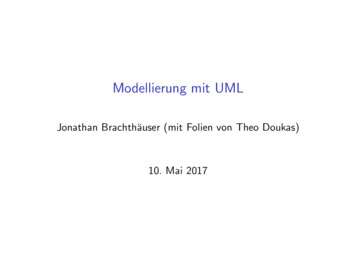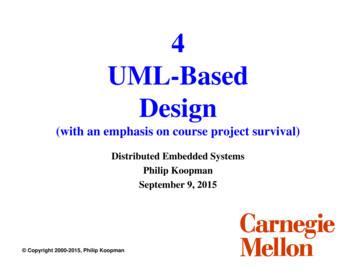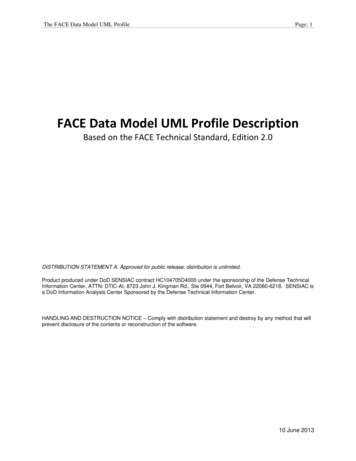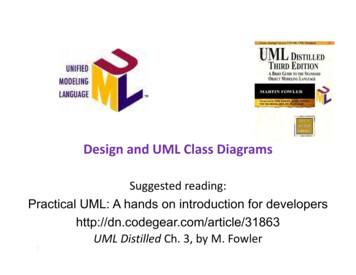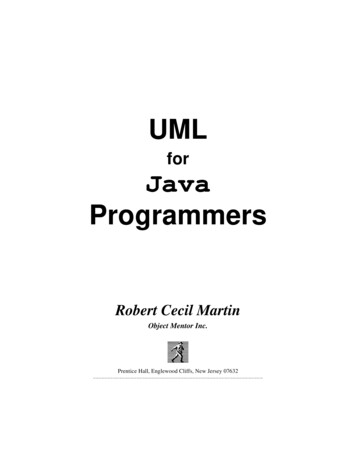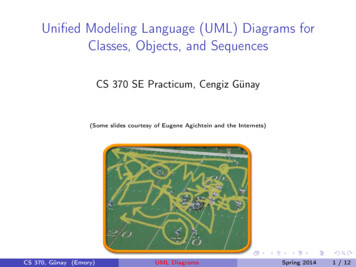
Transcription
Unified Modeling Language (UML) Diagrams forClasses, Objects, and SequencesCS 370 SE Practicum, Cengiz Günay(Some slides courtesy of Eugene Agichtein and the Internets)CS 370, Günay (Emory)UML DiagramsSpring 20141 / 12
AgendaMake-up lecture:You’ve already made a data model, but here’re some more detailsUnified Modeling Language (UML) Diagrams forClasses, Objects, and SequencesCS 370, Günay (Emory)UML DiagramsSpring 20142 / 12
Entry/Exit SurveysExit survey: Entrepreneurship, User Stories, Legal ProtectionFrom the two startups you heard about, what was the hardest partabout starting a company in your opinion?What’re benefits of describing project requirements in terms of userstories?What legal protection do you prefer to seek for your software?Copyright, trademark, or patents?Entry survey: UML diagramsBriefly tell me about an object-oriented feature that you used in yourprevious programming experiences.In data model diagrams, what else do you think would be useful todepict in addition to data attributes and relationships?Warning: Submit on Blackboard, but you won’t get points unless you alsoanswer the exit survey at the end.CS 370, Günay (Emory)UML DiagramsSpring 20143 / 12
Data model: Entity-relationship (ER) diagramsEntitiesAttributesRelationships (aggregation, multiplicity, . . . )What’s missing?CS 370, Günay (Emory)UML DiagramsSpring 20144 / 12
Data model: Entity-relationship (ER) diagramsEntitiesAttributesRelationships (aggregation, multiplicity, . . . )What’s missing?Methods/functionsCS 370, Günay (Emory)UML DiagramsSpring 20144 / 12
Classes: Encapsulate Data MethodsObject-oriented (OO) programming principles:Used by all mainstream software todayNot have a good grasp for it? Watch this lecture:https://www.youtube.com/watch?v DdUSzJ8taMsCS 370, Günay (Emory)UML DiagramsSpring 20146 / 12
Classes: Encapsulate Data MethodsObject-oriented (OO) programming principles:Used by all mainstream software todayNot have a good grasp for it? Watch this lecture:https://www.youtube.com/watch?v DdUSzJ8taMsNow we’ll learn how to depict classes in diagrams with UMLCS 370, Günay (Emory)UML DiagramsSpring 20146 / 12
UML class diagrams What is a UML class diagram? What does it represent?– A picture of the classes in an OO system, their fields andmethods, and connections between the classes that interactor inherit from each other What are some things not represented in a classdiagram?––––details of how the classes interactalgorithmic details; how particular behavior is implementedtrivial methods (get/set)classes that come from libraries (ArrayList, etc.)
Diagram of one class class name in top of box– write interface above interfaces'names– use italics for an abstract class name attributes– should include all fields of the object– also includes derived “properties” operations / methods– may omit trivial (get/set) methods– should not include inherited methods
Class attributes attributes (fields, instance variables)– visibility: public# protected- private package (default)/ derived– underline static attributes derived attribute: not stored, but canbe computed from other attributevalues
Class operations / methods operations / methods– visibility name (parameters ) :returnType– underline static methods– parameter types listed as (name:type)– omit returnType on constructorsandwhen return is void
Comments represented as a folded note, attached to theappropriate class/method/etc by a dashed line
Relationships between classes generalization: an inheritance (is-a) relationship– inheritance between classes– interface implementation association: a usage (is-part-of) relationship– dependency– aggregation– composition
Generalization relationships Hierarchies drawn top-down with arrowspointing upward to parent Line/arrow styles differ based on parent– class :solid, black arrow– abstract class :solid, white arrow– interface :dashed, white arrow Trivial / obvious relationships, such as drawingthe class Object as a parent, are generallyomitted
Associational relationships1. multiplicity *12.43.*(how many are used) 0, 1, or more 1 exactly between 2 and 4, inclusive 3 or more2. name3. navigability(what relationship the objects have)(direction)
Multiplicity one-to-one– Ex: each student must have exactly one ID card one-to-many– a RectangleList can contain 0, 1, 2, . rectangles
Association typesCar1 aggregation: "is part of"1Engine– clear white diamond composition: "is entirely madeof"– stronger version of aggregation– the parts live and die with thewhole– black diamond dependency: "usestemporarily"– dotted line or arrowLotteryTicketBook1*PageRandom
MultiplicityCustomerClassSimple1AggregationRental InvoiceAbstractClassRental ionCheckout ScreenDVD MovieVHS MovieVideo Game
StudentBody main (args : String[])Address- streetAddress : String- city : String- state : String- zipCode : long toString() : String1100Student- firstName : String- lastName : String- homeAddress : Address- schoolAddress : Address toString() : String
Tools for creating UML Violet (free)– http://sourceforge.net/projects/violet/ Rational Rose– http://www.rational.com/ Visual Paradigm UML Suite (trial)– http://www.visual-paradigm.com/– (nearly) direct download ?product vpuml&edition ce (there are many others, but many are commercial and costmoney)
Other free UML toolsDia (Gnome): https://wiki.gnome.org/Apps/DiaUmbrello (KDE): http://umbrello.kde.org/Ting Ting used: http://creately.com/
Class diagrams pros/cons Class diagrams are good for––––discovering related data and attributesgetting a quick picture of the important entities in a systemseeing whether you have too few/many classesseeing whether the relationships between objects are toocomplex, too many in number, simple enough, etc.– spotting dependencies between one class/object and another Not so great for– discovering algorithmic (not data-driven) behavior– finding the flow of steps for objects to solve a given problem– understanding the app's overall control flow (event-driven? webbased? sequential? etc.)
From classes to individuals (objects)
Related: Object diagrams shows an individual object, rather thanentire class– objectName : type– attribute value– objects can be connected by lines that statethe reason the two objects are talking
Object diagram example
What about time?
UML sequence diagrams sequence diagram: an “interaction diagram” thatmodels a single scenario executing in the system– perhaps second most used UML diagram (behind classdiagram)
Sequence diagram key parts participant: object or entity that acts in the diagram– diagram starts with an unattached "found message"arrow message: communication between participantobjects The axes in a sequence diagram– horizontal: which object/participant is acting– vertical: time (down - forward in time)
Representing objects Squares with object type, optionally preceded by"name :“ (if it clarifies diagram) object's "life line" represented by dashed verticalline
Messages between objects messages (method calls) indicated by arrow toother object– write message name and arguments above arrow
Messages messages (method calls) indicated by arrow to other object– dashed arrow back indicates return– different arrowheads for normal / concurrent (asynchronous) calls
Lifetime of objects creation: arrow with'new' written above it– notice that an objectcreated after the start ofthe scenario appearslower than the others deletion: an X at bottomof object's lifeline– Java doesn't explicitlydelete objects; they fallout of scope and aregarbage-collected
Indicating method calls activation: thick box over object's life line; drawn when object'smethod is on the stack– either that object is running its code, or it is on the stack waiting for anotherobject's method to finish– nest activations to indicate recursionActivationNesting
Selection and loops frame: boxaround part ofdiagram toindicate if orloop– if - (opt)[condition]– if/else - (alt)[condition],separated by horizontaldashed line– Loop - (loop)[condition or itemsto loop over]
sd emCheckoutProcessOrderConfirmOrderPlaceItemInOrder
Forms of system control What can you sayabout the controlflow of eachsystem?– Is it centralized?– Is it distributed?
Why not just code it? Sequence diagrams can be somewhat close to the codelevel So why not just code up that algorithm rather thandrawing it as a sequence diagram?– a good sequence diagram is still a bit above the level of thereal code (not all code is drawn on diagram)– sequence diagrams are language-agnostic (can beimplemented in many different languages– non-coders can do sequence diagrams– easier to do sequence diagrams as a team– can see many objects/classes at a time on same page (visualbandwidth)
L/UMLQuote.html "The trouble comes when people feel compelled to convey the whole model ordesign through UML. A lot of object model diagrams are too complete and,simultaneously, leave too much out. . Nor is UML a very satisfying programminglanguage."Eric Evans, 2003, Domain-Driven Design: Tackling Complexity in the Heart ofSoftware "The vocabulary and rules of a language such as UML tell you how to create andread well-formed models, but they don't tell you what models you should build andwhen you should create them. That's the role of the software developmentprocess."Grady Booch, James Rumbaugh, Ivar Jacobson, 2005, The Unified ModelingLanguage User Guide "The fundamental reason to use UML involves communication. Natural languageis too imprecise and gets tangled when it comes to complex concepts. Code isprecise but too detailed. So I use UML when I want a certain amount of precisionbut I don't want to get lost in the details."Martin Fowler, Kendall Scott, 2000, UML Distilled: A Brief Guide to the StandardObject Modeling Language
So UML allows you to say some of the things thatlanguages don’t allow you to say explicitly aboutsoftware systems It can be used effectively; it can be used horribly– Flon’s Law: Good programs can be written in anylanguage; and bad programs can be written in anylanguage Knowing the basics is important – it’s a commonlingo (and it sometimes shows up in interviews)
Exit Survey for this lectureExit survey: UML DiagramsWhen do you need an object diagram as opposed to a class diagram?Give an example from a program that you previously wrote wheremaking a sequence diagram would have been meaningful.Warning: Submit on Blackboard together with exit/entry surveys at thebeginning.CS 370, Günay (Emory)UML DiagramsSpring 201411 / 12
Next class:Version Control Systems
UnifiedModelingLanguage(UML)Diagramsfor Classes,Objects,andSequences CS370SEPracticum,CengizGünay (Some slides courtesy of Eugene Agichtein and the Internets)
